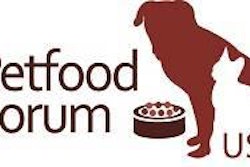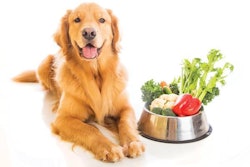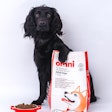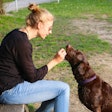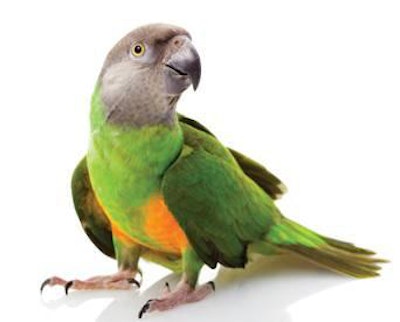
When analyzing the global petfood market, it’s easy to see that dogs and cats dominate. Dog food, cat food, dog treats and cat treats made up the vast majority of the global pet products market in 2014 (see Figure 1). Even so, there is a continuing global market for bird and small animal foods and treats, parts of an “other petfood” category that includes domestic and wild birds, reptiles and amphibians (herptiles), small mammals, rabbits, guinea pigs, hamsters, mice, ferrets, and fish.
In 2013, according to Packaged Facts’ latest report (“Pet Food in the US, 11th Edition,” September 2014), US retail sales of food for small animals other than dogs and cats totaled US$1.9 billion, up 6% from 2012 numbers. While 2014 showed a disappointing market growth of 1% for this segment of petfood, sales are expected to pick up and continue rising to US$2.2 billion by 2018 (See Table 1).
As for where those sales are concentrated, pet specialty stores are the leading channel for “other” petfood sales, according to Packaged Facts, claiming 40% of the market. Grocery and mass merchandisers make up another 34% of the market, while all other options round out the remaining 26%.
Unsurprisingly, the trends currently shaping the dog and cat food industries have spilled over into the other petfood categories. Pet humanization, arguably the most significant driving force for consumer petfood purchases today, has definitely extended to birds and small animals. As a result, related trends such as premium offerings—including natural, functional and gourmet foods and treats—and lifestyle- and species-specific formulas are gaining market ground. Convenience and ease of use for the humans purchasing the products are also highlighted trends.
Bird food and treats made up 49% of bird product sales in independent pet stores in 2013 (see Table 2). The category also included the sale of domestic birds, cages, toys and various accessories—in fact, the sales of birds themselves made up another 19% of total bird product sales in 2013. While the sales of caged bird food dropped slightly between 2011 and 2013 (from 30% to 27%), wild bird food, treats, and supplements and vitamins all increased slightly, showing a stable if not fast-growing market.
The idea that birds need more than a simple seed-based diet has been gaining traction as bird owners search for the most nutritious and balanced foods for their pets. Common diets now include both seeds and pellets, along with supplementary fruit and vegetable products.
Lafeber (www.lafeber.com), for example, offers nutritionally balanced base diets that include a mix of seeds and pellets. Lafeber’s Avi-Cakes are 50% seeds and 50% pellets, held together with a molasses binder. They are also omega-3 and -6 balanced to promote a healthy immune system and improve skin and feather quality, according to the company. Pellet Berries go further, focusing on birds who might turn their heads at a simpler pellet diet. Pellet Berries have a round shape offering a mix of whole cranberries, dates, apricots and natural grains (19%), along with a heavy serving of nutritionally balanced pellets (81%).
ZuPreem (www.zupreem.com) offers Smart Selects, which provides healthy and balanced formulas for birds using a mix of grains, seeds and fruits such as papaya, pineapple and coconut. ZuPreem’s Smart line also extends into bird treats, focusing on the same healthful variety trends. Treats come in Original, Tropical Bird and Blossom Biscuit, and are made with a mix of grains and vitamins for healthy snacking.
Higgins Premium Pet Foods (www.higginspremium.com) has released inTune Natural, a complete companion bird nutrition line with added vitamins, minerals and amino acids. inTune is made with natural flavors and aromas such as bananas and citrus, and relies on natural sources for its colors such as annatto seeds and turmeric root. Products contain fruits, vegetables and highly cooked grains, and formulas have been created for macaws, cockatiels and parrots.
Herptile foods and treats comprised 33% of total herptiles product pet store sales in 2013 (see Table 3), holding fairly steady from 2011 numbers. Live food and treats remained the same between 2011 and 2013, while packaged foods and treats slightly decreased in market share (to 8% from 11%). Sales of herptiles increased 2% between 2011 and 2013, from 20% of total herptiles product sales to 22%, while products like terrariums and accessories made up the remaining market share.
The most significant trend in herptile food and treats is nutritional balance. Nutrition supplements are becoming more prevalent, but so are complete diets and superfoods catering to specific reptile and amphibian species.
Zoo Med Laboratories (www.zoomed.com), for example, offers a line of gourmet amphibian and reptile foods. Items like gourmet box turtle food (blended with dried mealworms, mushrooms and strawberries), gourmet bearded dragon food (blended with dried mealworms, blueberries and dried rose flower petals) and gourmet aquatic turtle food (blended with dried shrimp, mealworms and whole cranberries) offer complete dietary options that meet the nutritional requirements of individual herptiles species. All formulas contain essential vitamins and minerals, with no artificial colors, flavors or preservatives added.
PetSmart’s (www.petsmart.com) All Living Things brand offers a reptile omnivore diet, Dried Omnivore Mix, which contains mealworms, crickets, carrots, bok choy, peas, green beans, zucchinis, apples and pears. The brand also offers more specific diets, including Freeze Dried Medley aquatic turtle food and Freeze Dried Medley bearded dragon food, designed to cater to those specific animals.
Exo Terra (www.exo-terra.com) has developed a series of specialized diets for most reptiles—herbivores, omnivores and carnivores—with the specific needs of these groups in mind. For example, iguana soft pellets are carefully formulated to ensure proper growth and health by providing complete and balanced nutrition, according to the company. The diet contains natural plant and fruit ingredients, and is fortified with optimal levels of vitamins, minerals and amino acids so no other supplements are required.
Small mammal petfood and treats made up 47% of all small mammal pet store product sales in 2013 (see Table 4). The purchase of those small mammals (hamsters and guinea pigs) made up another 21% of total sales. While food purchases dipped overall between 2011 and 2013 (50% of the market in 2011), the purchase of pets in this category actually increased (from 16% in 2011). As a result, the market remains fairly balanced. Sales of cages and habitats, toys and accessories rounded out the market.
Small animal products are also trending towards natural, premium options. Hays and foods that are GMO-free and all-natural can now be found on pet store shelves. Species-specific options are becoming even more prevalent, focusing on digestibility of ingredients, ideal pellet size and added nutrients.
Marshall Pet Products (www.marshallpet.com) has improved its premium ferret formula, increasing the amount of poultry to enhance ferrets’ growth and overall health. An increased amino acid profile improves digestibility, according to the company. Marshall has also introduced a grain-free Carnivore Plus ferret diet, which is gluten-free and made with fresh chicken as the number one ingredient.
Oxbow Animal Health (www.oxbowanimalhealth.com) has introduced Simple Rewards baked treats, made with nutritious ingredients such as fruits and vegetables, aromatic herbs and high-fiber Timothy hay. The treats, geared towards small pets like rabbits, guinea pigs and hamsters, come in apple & banana, bell pepper, carrot & dill, peppermint and cranberry varieties.
Vitakraft Sunseed (www.vitakraftsunseed.com) introduced its new Vita Prima Grainola Treat Bars at the March 2015 Global Pet Expo. The bars are handcrafted and oven baked, with fruits and vegetables mixed throughout. The crunchy texture satisfies pets’ natural gnawing instinct, according to the company, and wildberry drops have been added to certain small animal bars.
In spite of the differences in dietary needs for birds, herptiles and other small animals, pet owners are looking for the same things: nutrition balance, premium options and the convenience of feeding their pets complete diets in one formula.





